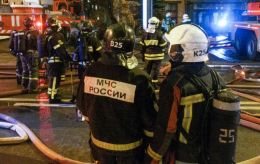India abandoning Russian weapons in favor of latest US developments - Bloomberg
 Photo: India is fending off Russian weapons (Getty Images)
Photo: India is fending off Russian weapons (Getty Images)
India has sharply reduced its orders for military equipment from Russia and is now buying more from Western suppliers. This is a significant policy shift for a country that has traditionally depended on arms from Moscow, according to Bloomberg.
India and Russia's plans to jointly develop and produce helicopters and advanced fighter jets were shelved some time ago, senior Indian officials told the agency.
A separate proposal to lease a nuclear submarine from Russia to train Indian crews is also unlikely to materialize, they said, noting that the South Asian country builds its vessels. Two warships and batteries for an anti-missile shield, which were ordered before the war against Ukraine, are the only outstanding items that New Delhi has not yet received from Moscow.
India, the world's largest arms importer, is buying less and less from Russia. Only 36% of India's arms imports came from Russia last year, down from 76% in 2009, according to a March report by the Stockholm International Peace Research Institute.
India's move to divest from Russian arms underscores Prime Minister Narendra Modi's efforts to steadily reduce its dependence on Moscow, while his government continues to buy cheap energy from Russia and provide diplomatic support to Vladimir Putin. At the same time, India has moved closer to the US defense orbit, providing an anchor for the relationship just as Donald Trump takes office, threatening higher tariffs.
Procurement in United States
New Delhi's rejection of Russia has helped US suppliers. According to SIPRI, India is now buying more from Western companies and is trying to develop its weapons with the support of the United States and France. Over the past two decades, Washington has eased restrictions that prohibit developing countries from gaining access to advanced technologies.
According to a report by the Congressional Research Service, since 2018, India has signed contracts worth about $20 billion for products manufactured in the United States. In October, this South Asian country gave the green light to a deal worth more than $3 billion for the supply of 31 long-range drones manufactured by the American defense giant General Atomics.
India's state-owned Hindustan Aeronautics Ltd. and General Electric Co. are also close to signing an agreement to jointly produce an improved version of jet engines for the next generation of light combat aircraft, anonymous Indian officials said. Authorities agreed on the terms of the partnership during Modi's state visit to the United States last year.
Cheap Russian weapons
Russian weapons are often cheaper than Western weapons. But they need to be repaired frequently, which affects their attractiveness and makes them more expensive in the long run, another senior Indian official said.

bloomberg.com
“India has slowly shifted to Western-origin platforms because the military is increasingly comfortable with such technology,” said Anit Mukherjee, a senior lecturer at King's College London who specializes in Indian military and foreign policy.
The pivot toward Moscow is a defining feature of Modi's foreign policy. It emphasizes India's efforts to balance ties with Russia, which sells cheap oil to New Delhi, and the United States, which has helped boost defense production and add jobs in the South Asian country.
Russia's war against Ukraine has accelerated India's reduction in purchases of Russian weapons. The delay in the delivery of the missile shields is proof of Russia's strained capabilities, said Sushant Singh, a lecturer in South Asian studies at Yale University.
Russia's ties to China have further complicated the equation. “Russian defense industries’ reliance on Chinese electronics is problematic and a red flag for India,” Mukherjee said.
Despite this, New Delhi and Moscow jointly produce rifles and missiles in India, and Russia remains the largest supplier of military equipment to the South Asian country. However, the bulk of the imports consist of spare parts to keep outdated equipment operational. This includes everything from basic rifles to army tanks and India's main fighter jet.
“These will remain in service for decades and India will need spare parts and ammunition from Russia for a long time,” Singh said.
New Delhi's fighter jet fleet has been steadily shrinking as it faces two hostile neighbors, China and Pakistan.
In addition, India remains dependent on Russia for its nuclear capabilities.
“Russia remains the only country which offers its nuclear submarines to India,” Mukherjee said. “India’s partnership with Western countries will be incomplete until both sides find a way to talk about nuclear issues.”
India has sharply increased its trade with Russia since the start of Russia's full-scale invasion of Ukraine, in particular by buying its oil, which is a major source of revenue for the Kremlin's military machine.

